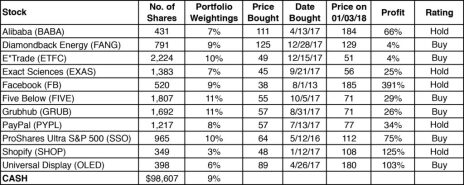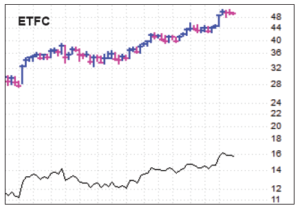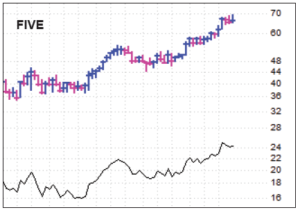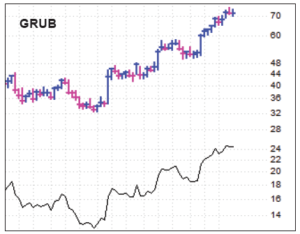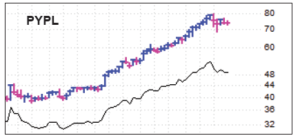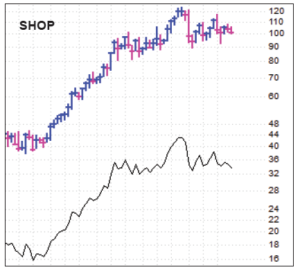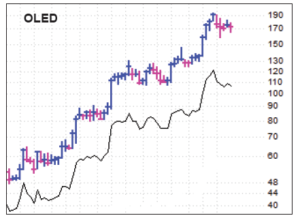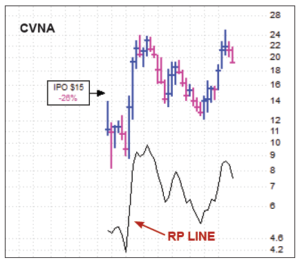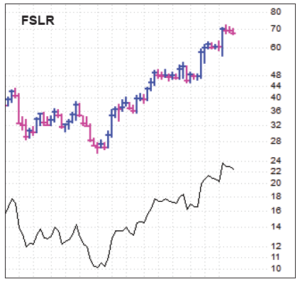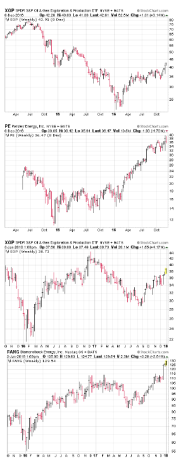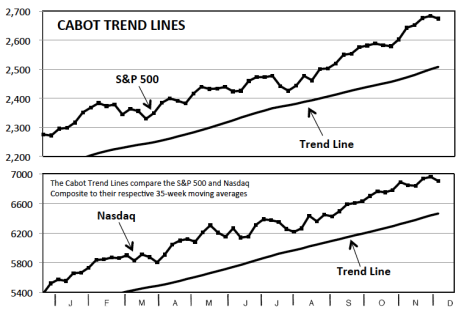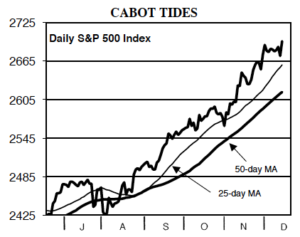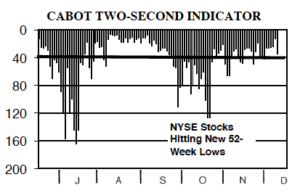The Model Portfolio is more than 90% invested and off to a good start this year. In tonight’s issue, we write about our newest addition and the excellent relative strength it’s shown in recent months; we think it’s a liquid leader of the new energy rally. We also write about some recent IPOs, other stocks we’re watching and, of course, dive into all of our recommended names.
Cabot Growth Investor 1384
[premium_html_toc post_id="142974"]
The Big-Picture Bull Market Rolls On
2017 is in the books, and as we mentioned in our last issue, it was a great year—the Model Portfolio finished up 40% on the button, roughly double the S&P 500’s performance. And since taking over at the start of 2007, we’ve outdone the S&P by more than a third over the past 11 years—even including dividends paid). We hope you made great gains, too.
But now our focus is on 2018. And while we offer no concrete predictions, our biggest convictions lie in the market’s mega- and longer-term trends. On a mega-trend basis, we continue to feel that 2013 marked the end of a 13-year secular bear market where valuations and sentiment contracted and the market made no net progress. Given that secular bull phases tend to last 10 to 15 years (sometimes longer), we’re probably in the third to fourth inning of a new mega-uptrend.
On a regular long-term basis, we also believe the 2016 U.S. presidential election kicked us out of a mini-bear market (the market went nowhere from early 2015 through October 2016) that essentially re-set the market after a few good years. Throw in the fact that our Cabot Trend Lines remain firmly bullish (as they have since April 2016!) and some longer-term studies (like the one we mentioned on page 1 of the last issue), and we feel strongly that the overall bull market has plenty of room to run.
The near-term, though, has the potential for potholes according to some secondary measures. Elevated sentiment is one (Investors Intelligence shows four times as many bullish advisors as bearish ones!) and the declining number of new highs is another—yesterday’s Nasdaq surge produced 174 stocks hitting new highs, down from 264 in mid-December, 308 around Thanksgiving and 367 in early October. Throw in the fact that January often has many crosscurrents (including earnings season later this month), and it’s important to keep your eyes open for trouble and honor your mental stops.
Even so, the rubber-meets-the-road evidence (the trend and price/volume action of the major indexes and leading stocks) is still bullish. So, as we start 2018, we’re positioned just as we were for most of 2017: heavily invested.
[highlight_box]WHAT TO DO NOW: In the Model Portfolio, we pared back to nearly 30% cash when growth stocks got hit after Thanksgiving, but we’ve now put about two-thirds of that back to work, including last week’s addition of Diamondback Energy (FANG). We now have 9% in cash, room for one more stock if the right setup emerges.[/highlight_box]
Model Portfolio Update
While 2017 finished up as our best year in over a decade, the past month or so has been a bit tricky. When the year’s leading growth stocks hit the skids after Thanksgiving, we got knocked out of a couple of stocks and booked partial profits in two others, resulting in a nearly 30% cash level.
But as the market stabilized and new leadership emerged, we’ve put about two-thirds of that cash to work, first in E*Trade and last week in Diamondback Energy, which looks like a liquid leader in the oil patch. We’re now carrying about 9% in cash.
As we wrote on page 1, January is usually a volatile month. Because of the many crosscurrents, we’re content to stand pat for now. But, as always, we’ll be keeping an eye on our stock’s mental stops and look to rotate into fresher leading stocks should any of ours break down.
Current Recommendations
HOLD—Alibaba (BABA 184)—BABA’s base-building effort has now entered week six, and looks normal to this point, having fallen a max of 14% from its high after a big run (running from 120 to 191 to a low of 164) before shooting higher to start 2018. Short-term, we’ve written that it wouldn’t surprise us if BABA needed to pull back more before resuming its advance, which prompted a few subscribers to ask “If you believe that, why not sell it and buy it back if/when BABA gets going again?” The answer: The big money is in the big swing—losing our position in a stock that still has a lot of upside potential isn’t worth the risk for potential savings of a few percent on the downside. Plus, the “sell now and buy it back lower” game is easier said than done. (Just take this week’s pop, for example.) That doesn’t mean you can’t consider partial profits (we sold half our initial stake in September), but given the fundamental (analysts have bumped up their earnings estimates to +30% in fiscal 2018, which starts April 1) and technical evidence, we advise sitting tight and using a relatively loose leash on your remaining shares.
BUY—Diamondback Energy (FANG 129)—We normally don’t trade during the last week of the year, but the recent action of energy stocks as a whole—and FANG in particular—had us take the plunge on last Wednesday’s update. We write about the stock’s excellent relative strength later in this issue, which was a big reason we bought it. But the fundamentals are also top-notch—despite so-so oil prices (about 75% of the firm’s output is oil), Diamondback’s acreage is so lucrative and its operations are so efficient that the company was able to expand production by a whopping 80% last year! And that expansion was all self-funded, coming from its own cash flow! Diamondback is profitable as long as oil is north of $30 per barrel, and management said in the latest conference call that, at current production levels, every dollar that oil prices rise would boost its cash flow by $30 million per year. Obviously, all bets are off if oil prices tank, but given the fundamentals and the recent breakout, we think buying FANG here presents a good risk-reward situation.
BUY—E*Trade Financial (ETFC 51)—ETFC bided its time during the last couple of weeks of the year, which is fine with us, as the stock is holding the majority of its strong breakout action from early December. During the past couple of months, we’ve generally seen more money begin to flow into equity funds—that doesn’t directly help E*Trade (which makes most of its money via interest and commissions), but it is a sign that investor sentiment is beginning to perk up, which should lead to more trading and customer assets, boosting the firm’s bottom line. The firm also announced that it’s begun offering bitcoin futures on its platform. Overall, we think the path of least resistance here is up, and that ETFC is poised to be a leading Bull Market stock. We’ll stay on Buy.
HOLD—Exact Sciences (EXAS 56)—EXAS wobbled right out of the gate Tuesday morning, but a couple of analysts reiterated their positive outlook during the day, which brought in some support, and today the stock perked back up to its recent highs—all of which looks like typical early-January volatility to us. As in past years, it’s likely that Exact will give a first-look at Q4 results (at least in terms of Cologuard tests and, possibly, an early outlook for 2018) early next week or even over the weekend, which should move the stock. For our part, we’ll continue to let EXAS tell its own story—if it closes below support near 49, we’ll sell our remaining shares and move on, but any strong show of buying could tell us the uptrend is resuming.
HOLD—Facebook (FB 185)—As Facebook has matured during the past couple of years, the stock has alternated multi-month periods of outperformance and underperformance. In 2017, for instance, its relative performance (RP) line surged through July but chopped sideways afterward. Now the stock is beginning to perk up, though net-net, it still hasn’t made any progress since late October. Because of that, we’ll stay on Hold, though we’re optimistic the next major move will be up. Earnings, which are likely out near the end of the month, will probably tell the tale.
BUY—Five Below (FIVE 71)—We’re not big on predictions, but we think Five Below has a great chance to be a top performer in 2018 given the bullishness of its sector (which has turned up after spending most of last year in the dog house), its chart (FIVE has decisively cleared years-long resistance in the mid-50s) and, most importantly, its story (many years of rapid store growth ahead, combined with excellent same-store sales growth, with a boost from the corporate tax cut). The stock chopped around for most of December but remains in a firm uptrend and hit new highs this week. A dip toward the 25-day line (now near 65.5) should provide a good entry point.
BUY—Grubhub (GRUB 71)—Grubhub has been quiet on the news front since it announced a nationwide delivery deal with Cheesecake Factory in mid-December. The stock has finally begun to catch its breath, dipping to its 25-day line this week; a deeper retreat to its 50-day line (near 66) is possible, but would mark a solid entry point in our book. Either way, we remain bullish here for all the reasons we’ve outlined over the past few months. We’ll stay on Buy.
HOLD—PayPal (PYPL 77)—PYPL broke out at 44 last April, ran as high as 79 and then pulled back to 69 before bouncing—all normal action in our opinion. As with some other growth winners from last year, the stock looks like it might need to rest after a seven-month run, but the odds favor higher prices over time. Continue to practice patience if you own some.
BUY—ProShares Ultra S&P 500 Fund (SSO 112)—SSO was a relatively “easy” hold (it’s never easy, but you know what we mean) in 2017, as the volatility in the major indexes was very low. And with the trends still pointed up, we’re keeping our Buy rating intact. Looking ahead, we’re guessing this year will prove more challenging, but a few key pieces of evidence tell us that the odds favor the market moving higher during the next six to 12 months. Thus, we could trim our position (currently 10% of the Model Portfolio) whenever the intermediate-term uptrend falters (Cabot Tides turn negative), but as with a couple of our other winning positions, we’ll likely aim to hold a chunk of SSO through a mild correction, thinking that the overall bull market will carry it higher over time. Right now, though, we’re still thinking this leveraged long index fund is a good buy around here or on dips of a point or two.
HOLD—Shopify (SHOP 108)—We’re likely getting close to do-or-die time for Shopify, as the stock has stabilized for a couple of months and its long-term 200-day line has risen to the mid-90s. (Our mental stop remains around 90, which is near the stock’s lows of the past few months.) We’ll see if the company provides some numbers regarding its clients’ activity over the holiday shopping season and whether that affects the stock. Thinking ahead, a push through the 115 area would be a solid sign that SHOP’s major uptrend is resuming, and could prompt us to buy a few more shares given our small position (just 3% of the Portfolio). For now, though, we advise patience and honoring our mental stop.
BUY—Universal Display (OLED 180)—OLED has scuffled a bit after reports that demand for Apple’s iPhone X (which uses organic light emitting diodes from Samsung, one of Universal’s big customers) was likely lower than expected during the fourth quarter. That said, shares found support near the 50-day line last week, and the firm’s story is about a lot more than just Apple. Sure enough, today, the stock ramped on excellent volume (there were some reports about larger screens in the next iPhone, but we don’t think that caused the buying) as investors started to refocus on the bigger picture. Should OLED falter back into the mid-150s, it might be a sign that big investors are sniffing out slowing demand. But right now, we think the stock is showing signs of coming back to life after a five-week rest. We’ll stay on Buy.
Watch List
Nutanix (NTNX 37): NTNX is a new name that is leading what appears to be a new, rapidly-growing industry—hyper-converged infrastructure allows all of a big firm’s various applications to run and be managed from one platform.
Planet Fitness (PLNT 33): We’re seeing many strong cookie-cutter retail stocks that we like. PLNT is certainly one of them, as are Floor & Decor (FND) and Ollie’s Bargain Outlet (OLLI).
Roku (ROKU 55): Roku has transformed itself from a hardware story (selling TVs and streaming devices) to a service story (16 million people on its platform, which leads to big advertising and licensing revenue), and that’s one reason the stock is one of the hottest IPOs in the market. If you buy some, though, the stock needs to be handled with care—see our IPO write-up later in this issue.
Splunk (SPLK 88): SPLK settled down nicely after its big earnings gap and is beginning to resume its run this week. Analysts see earnings surging 47% this year.
Other Stocks of Interest
The stocks below may not be followed in Cabot Growth Investor on a regular basis. They’re intended to present you with ideas for additional investment beyond the Model Portfolio. For our current ratings on these stocks, see Updates on Other Stocks of Interest on the subscriber website or email mike@cabotwealth.com.
Carvana (CVNA 18) — Used cars are an industry that’s worth $710 billion annually, and Carvana has a unique approach that’s carving out a great niche. Carvana buys cars, inspects the heck out of them and then offers them online with relevant stats via a 360 degree interactive viewing app. Car shoppers can buy, get financing, negotiate trade-ins and schedule delivery all without leaving home and at lower prices than conventional dealers. Revenue grew by 213% in 2015 and 180% in 2016 and likely booked another triple-digit year in 2017. The company doesn’t have earnings because it’s plowing its money into expansion—its offerings are currently available to about 20% of U.S. markets, but the firm is expanding aggressively. CVNA came public in April 2017 and is still volatile, but the potential here is enormous.
First Solar (FSLR 70) — While solar energy keeps making progress, solar companies have been buffeted by changes in economic growth, cutthroat competition and shifting policies on rebates and incentives. First Solar has always been a top pick in the industry because of its proprietary thin-film technology that keeps costs down. And in 2018, the company will roll out a new Series 6 module that is a step-function improvement in cost and performance (driving down the price per watt by 40% by 2020). Due to anticipated demand, First Solar will nearly triple its capacity over the next three years. The capital expenditures required to shift to the Series 6 will keep earnings under pressure this year, but investors are looking toward a floor in the bottom line starting late this year. FSLR has been trending higher for months, and picked up steam in early December after it released the details of its Series 6 plan. Pullbacks look buyable.
Steel Dynamics (STLD 46) — The steel business is highly cyclical and highly competitive, but Steel Dynamics, which has been profitable every year since 2002, has been able to outlast all challenges. Steel Dynamics is the youngest producer in the U.S. and runs extremely efficient mills and metal recycling plants (which account for nearly one quarter of revenues). The company has grown through both expansion and acquisition, but the major boost to business has been the imposition of tariffs on Chinese steel, which has lifted prices. The steel sector has come back to life, and Steel Dynamics is the best in class. STLD has been trading sideways since it capped a big rally in late 2016 at 40, but the stock broke out to new highs in December. This isn’t really a growth stock, but as a rebound story off a big base (with a 1.4% dividend yield), it’s worth a look.
Vertex Pharmaceuticals (VRTX 152) — The biotech sector got knocked around a bit in late 2017, but started to pick up in the last half of December. Vertex Pharmaceuticals is a profitable biotech that has two treatments for cystic fibrosis on the market and a robust pipeline of candidate drugs for cystic fibrosis and various cancers. Revenue was up an average of 49% per quarter through Q3 and earnings growth averaged 210%. VRTX topped a run from 71 in late 2016 to 168 in July 2017, then drifted back to 137 in early December. The stock found support at its 200-day moving average, but could kick back into gear if investors warm up to the biotech sector again.
A Classic Example of Relative Strength
Diamondback Energy (FANG)
Relative strength analysis is mostly concerned with keeping an eye on strong stocks and sectors, but we also like to keep an eye on high-potential, beaten-down areas and identify the most resilient stocks in those groups. Once the sector turns up, stocks that failed to decline much are usually good bets to make solid runs.
Commodity stocks often provide opportunities in this regard—when, say, oil prices and stocks collapse, the first stock out of the gate usually has a good run. One example that comes to mind was after the major bottom in energy stocks back in early 2016—despite the Oil & Gas SPDR (XOP) sector being in tatters, Parsley Energy (PE) had been hitting higher lows for months and broke out of its launching pad just three weeks after the group got going.
Despite seeing this, we didn’t pull the trigger, which proved costly. PE nearly doubled from the start of March through Thanksgiving!
We’re seeing a similar setup now and are aiming to take advantage of it. While it wasn’t as bad as the 2014-2016 bear move in oil stocks, last year’s down-move in the sector was both tedious (XOP moved nearly straight down for nine straight months!) and severe (down 36% from high to low). But XOP bottomed in August, and after some gyrations, lifted to multi-month highs in the second half of December.
Similar to the 2016 upturn, most energy explorers are now coming up off their bottoms, like the sector itself. But Diamondback Energy (FANG) looks like a major exception—as XOP crawled ahead in September and October, FANG bolted ahead nine weeks in a row (a sign of institutional accumulation). And now, after tightening up for a few weeks, Diamondback’s stock has shot ahead to all-time highs, even as XOP remains more than 50% off its 2014 apex.
Energy stocks are always fickle, with the price of oil and natural gas (and perception about economic growth overall) pushing and pulling the group as much as any single company’s fundamentals. But the market is an odds game, and after years in the doghouse, energy stocks appear to have bottomed out and Diamondback looks poised to lead a new uptrend. We added it to the Model Portfolio last week. BUY.
Lots of Intriguing IPOs
After 2016 brought a complete dearth of new IPOs (the $18.8 billion raised that year was even below 2008 and 2009!), last year saw the new issue spigot open somewhat—new issues increased from 105 to 160, with the amount raised rising to $35.5 billion (about average for the past decade). And more important to us, many of these new issues have excellent growth stories and numbers—the type of stocks that can form new leadership.
We’ve mentioned a few of these stocks before, such as Roku (ROKU), Floor & Decor (FND), ProPetro (PUMP) and Carvana (CVNA) and many others. All have great potential in our view, but all have challenges, too—most are either thinly traded, extremely volatile or both.
Take Roku, a company we’re keen on given its leadership position in the connected-TV industry. Because its platform is integrated on many smart TVs and its streaming device leads the market (37% of all streaming devices are made by Roku), the firm had 16.7 million active users of its streaming platform at the end of September, up 10.5% from the prior quarter and up 48% from a year ago, and that in turn boosts advertising and licensing revenue.
The stock has been very strong, and it’s very liquid (10 million shares trade per day), but it’s also extremely wild—even after calming down a bit near year-end, the stock still moves an average of 3.6 points per day from high to low. That’s nearly 7% per day!
ROKU has been riding its 25-day line higher since blasting off on earnings in November, and the stock appears to want to go higher after a recent consolidation. However, it’s best to handle it with care if you buy—keep any position about half (dollar-wise) of what you’d normally purchase, and use a looser loss limit, possibly 20% to 25% from your buy price.
The story is similar for most of the other IPOs—smaller positions and looser stops will allow you to control risk, hold on through sharp (but normal) dips and potentially make great gains if any turn into homeruns.
Cabot Market Timing Indicators
It’s a new year, but the same bull market, as the intermediate- and longer-term trends of the major indexes are pointed up and the broad market seems to be kicking into gear. It’s a good bet to expect higher volatility in the weeks ahead, but with the evidence bullish, we remain heavily invested.
Cabot Trend Lines: Bullish
The Cabot Trend Lines remain in the bull camp, with the S&P 500 and Nasdaq closing out the year 6.6% and 6.8% above their respective 35-week moving averages. We haven’t gotten a new signal from our 7.5% Rule (mentioned on page 1 of the last issue), but nevertheless, the positive stance of the Trend Lines and some other longer-term studies point toward higher prices in the months ahead.
Cabot Tides: Bullish
Our Cabot Tides also remain firmly bullish, with all five of the indexes we track (including the S&P 500, daily chart shown here) nicely above their lower (50-day) moving averages, especially after the surge to begin the year. There’s no question that the larger-cap indexes have outperformed lately, but what matters most is the overall trend, which is still pointed up.
Two-Second Indicator: Unhealthy
The Two-Second Indicator is right on the edge of turning positive, having registered six straight days of fewer than 40 new lows coming into today. Coming at year-end (when trading was generally lackluster and on very light volume), those readings are a smidge less reliable, but it’s still a positive sign. Another couple of days of sub-40 readings would likely result in a green light.
[premium_html_footer]
Send questions or comments to mike@cabotwealth.com.
Cabot Growth Investor • 176 North Street, Post Office Box 2049, Salem, MA 01970 • www.cabotwealth.com
All Cabot Growth Investor’s buy and sell recommendations are made in issues or updates and posted on the Cabot subscribers’ website. Sell recommendations may also be sent to subscribers as special bulletins via email and the recorded telephone hotline. To calculate the performance of the portfolio, Cabot “buys” and “sells” at the midpoint of the high and low prices of the stock on the day following the recommendation. Cabot’s policy is to sell any stock that shows a loss of 20% in a bull market (15% in a bear market) from our original buy price, calculated using the current closing (not intra-day) price. Subscribers should apply loss limits based on their own personal purchase prices.
Charts show both the stock’s recent trading history and its relative performance (RP) line, which shows you how the stock is performing relative to the S&P 500, a broad-based index. In the ideal case, the stock and its RP line advance in unison. Both tools are key in determining whether to hold or sell.
THE NEXT CABOT GROWTH INVESTOR WILL BE PUBLISHED JANUARY 17, 2018
We appreciate your feedback on this issue. Follow the link below to complete our subscriber satisfaction survey: Go to: www.surveymonkey.com/marketlettersurvey
Neither Cabot Wealth Network nor our employees are compensated by the companies we recommend. Sources of information are believed to be reliable, but are in no way guaranteed to be complete or without error. Recommendations, opinions or suggestions are given with the understanding that subscribers acting on the information assume all risks. © Cabot Wealth Network. Copying and/or electronic transmission of this report is a violation of U.S. copyright law. For the protection of our subscribers, if copyright laws are violated, the subscription will be terminated. To subscribe or for information on our privacy policy, call 978-745-5532, visit www.cabotwealth.com or write to support@cabotwealth.com.
[/premium_html_footer]


